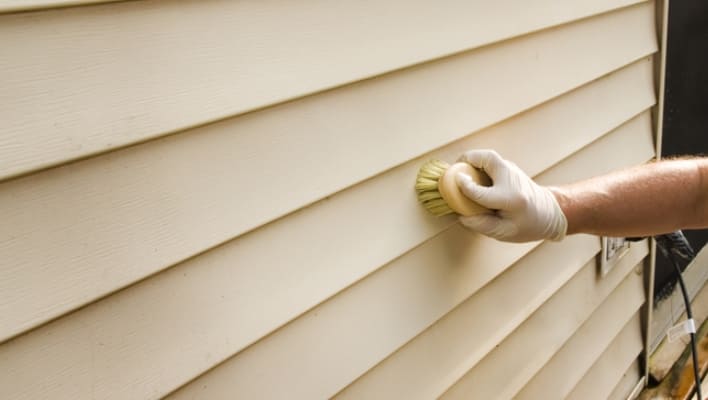The question on many minds is: “Can you use stain in a paint sprayer?” The answer is a definitive yes! I recently tested out the Wagner FLEXiO 3000 Paint Sprayer with an exterior semi-transparent wood stain, and I was really impressed with the results.
Surprisingly, staining with a sprayer might even be easier than painting, as the emphasis is less on achieving a flawless finish. Let’s delve into this topic further to understand why using stain in a paint sprayer can be a viable option for your projects.
Table of Contents
- Can You Use Stain In A Wagner Paint Sprayer?
- Is it better to spray or brush stain?
- Spraying On Wood Stain With Sprayer:
- Brushing Stain:
- Can you put deck stain in a paint sprayer?
- Do you have to thin stain for spraying?
- How to Dilute Wood Stain for spraying with paint sprayer?
- Can you spray stain with an airless sprayer?
- Conclusion On staining with a sprayer:
- Martina Hitchcock
Can You Use Stain In A Wagner Paint Sprayer?
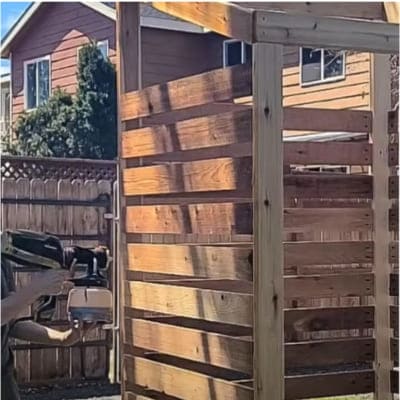
Yes, using stain in a Wagner paint sprayer can be a convenient and efficient way to apply it to your projects, especially if you have a large surface area to cover like a wooden structure or furniture.
I recently had the opportunity to use the Wagner Flexio 3000 paint sprayer for staining a firewood storage rack, and I must say, the process was quite straightforward.

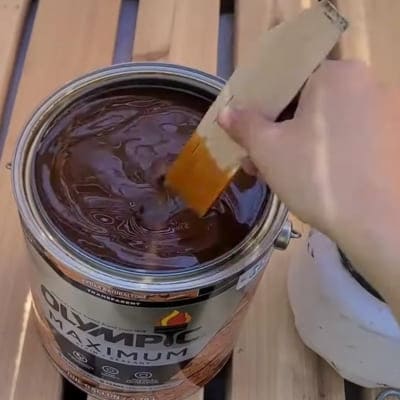
First things first, it’s essential to prepare your materials. For staining, this simply involves opening the can of stain and giving it a good stir to ensure it’s well mixed.
Learn more about the differences between stain and paint for better understanding.

Then, pour the stain into the cup of the sprayer. While this step can get a bit messy, it’s nothing a quick wipe-up can’t fix. Next, it’s important to adjust the settings on the sprayer according to the manufacturer’s recommendations.
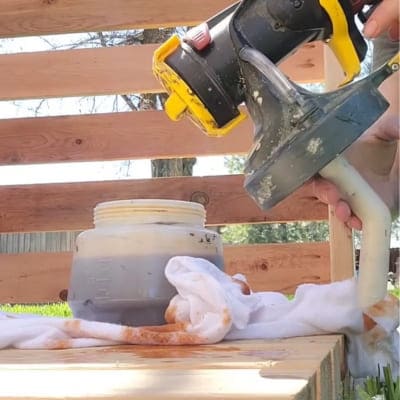
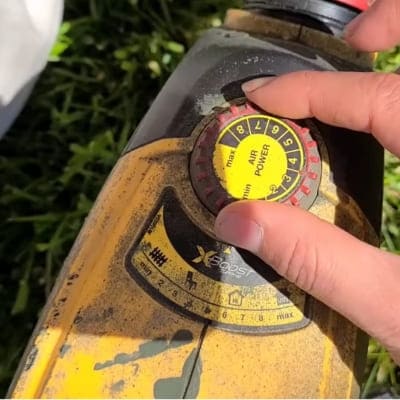
This includes ensuring the pickup tube is positioned correctly, tightening all connections, and setting the material flow control and spray width to your desired levels.
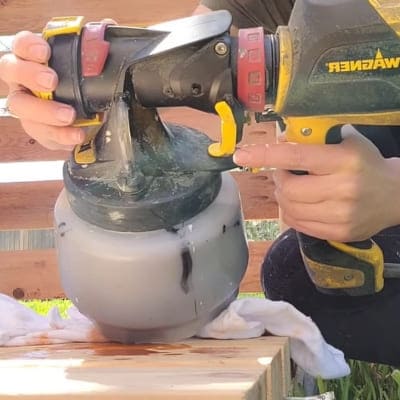
Before you begin, make sure to test the settings on a hidden spot or spare wood to check if they’re right for your project. Once everything’s ready, start spraying.
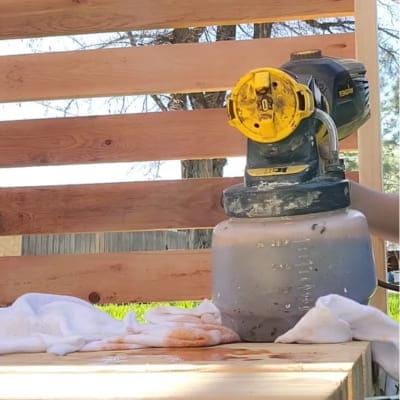
Keeping your arm moving at a consistent speed and maintaining a consistent distance from the surface are key to achieving an even finish. I found it helpful to work in smooth passes, adjusting the spray shape as needed for different areas of the project.
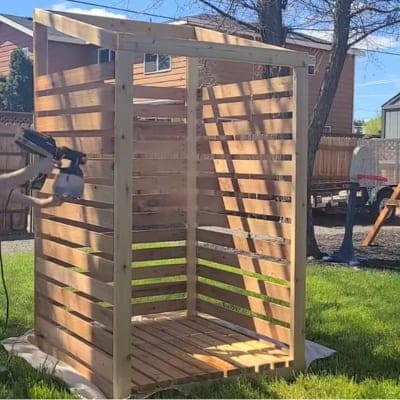
After applying the stain, allow it some time to soak into the wood. Depending on the type of stain and the desired finish, you may need to wipe off any excess with a clean cloth.

In my experience, the Wagner Flexio 3000 provided excellent coverage, getting into all the nooks and crannies of the storage rack effortlessly. Check out the final result after using wood stain in a paint sprayer.
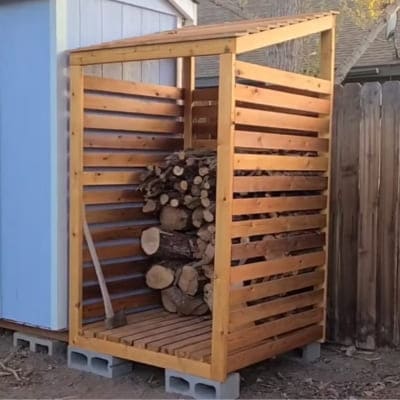
Cleanup process is relatively straightforward as well. After releasing the pressure and pouring any excess material back into the can, I filled the cup with water and sprayed it out while gently shaking the sprayer to loosen any remaining stain. Then, I disassembled the nozzle and other parts for a thorough cleaning in warm, soapy water.
Overall, using stain in a paint sprayer can yield professional-looking results with minimal effort. Whether you’re staining a large outdoor structure or a small piece of furniture, the Wagner Flexio 3000 paint sprayer is a reliable choice that makes the process smooth and efficient.
Is it better to spray or brush stain?
Deciding whether to spray or brush stain depends on different things like the size of your project, the surface you’re working on, what kind of finish you want, and what you’re comfortable with. Here’s what to think about:
Spraying On Wood Stain With Sprayer:
- Using a sprayer is usually quicker, especially for big areas or detailed work.
- Spraying can make the stain look more even, especially on smooth surfaces.
- Spraying can create a mist that might go where you don’t want it, so you need good ventilation and protection.
- You’ll need a sprayer, and cleanup might take a bit longer.
Brushing Stain:
- With a brush, you have more control, especially in tight spots or areas that need careful work.
- You’re less likely to waste stain because there’s no mist like with spraying.
- Brushes can get into corners and spots that a sprayer might miss.
- You just need brushes and maybe a roller, which is simpler, especially for smaller jobs.
Here are some things to consider when deciding:
Surface Type: Smooth surfaces usually work better with spraying, like cabinets, while rough surfaces might be better with brushing, like wood siding.
Project Size: Spraying is great for big jobs like decks, while brushing might be easier for smaller projects.
Finish Look: Different methods can give different looks. Brushing might give a more handmade look, while spraying might look more consistent.
Skill Level: Spraying can be a bit tricky to get right, so if you’re new to this, brushing might be easier to start with.
Can you put deck stain in a paint sprayer?
Yes, you can use deck stain in a paint sprayer, but it’s essential to choose the right type of sprayer designed for thicker materials like stains. In fact, I have also used airless sprayer for spraying fence and deck. Look for a sprayer specifically labeled for stains or one with an adjustable nozzle to control the flow. Before using, ensure the stain is properly mixed and strained to prevent clogs.
Do you have to thin stain for spraying?
To prepare stain for spraying, adjust the thickness based on your sprayer type and the stain’s consistency. Some stains are formulated to be used directly from the container without thinning, while others may require more thinning with an appropriate solvent for optimal spraying results.
How to Dilute Wood Stain for spraying with paint sprayer?
Diluting wood stain is a straightforward process that varies depending on the type of stain being used. For oil-based stains, such as traditional wood stain or gel stain, mineral spirits are used for thinning. Water is the preferred choice for diluting water-based stains, while lacquer thinner is suitable for lacquer-based stains.
To dilute wood stain effectively, follow these general steps:
Prepare the Stain: Stir the stain thoroughly to mix any settled pigments, then pour an appropriate amount into a separate container.
Add Thinner: Gradually add the appropriate thinner (mineral spirits, water, or lacquer thinner) in small increments, mixing thoroughly after each addition. It’s essential to add thinner slowly to avoid over-dilution.
Test the Stain: Apply the thinned stain to a scrap piece of wood to assess the color and consistency. If the desired result is not achieved, adjust the amount of thinner accordingly and retest.
Apply the Stain: Once satisfied with the diluted stain, apply it to the wood surface using a rag or foam brush, ensuring even coverage.
Wait for Drying: Ensure the stained wood dries completely as per the stain’s instructions. Sanding may be required between coats for water-based stains to smooth the surface.
Repeat if Necessary: If a darker color is desired, repeat the staining process until the desired shade is achieved.
Can you spray stain with an airless sprayer?
Yes, you can spray stain with an airless sprayer. It’s a popular method for even application over large areas. Selecting airless sprayer significantly speeds up the process compared to traditional brushes and rollers, potentially completing the project up to 10 times faster. This method ensures a more uniform application, saving both time and effort while achieving professional-looking results.
Conclusion On staining with a sprayer:
In conclusion, using stain in a paint sprayer is possible and can be effective if done correctly. Make sure the sprayer is compatible with stains and adequately cleaned between uses, using a paint sprayer for staining can provide efficient and even coverage, saving time and effort. Just be sure to follow manufacturer guidelines for best results and maintain proper cleaning practices to prevent clogs and ensure longevity of the equipment.

Martina Hitchcock
Martina Hitchcock is a versatile author with expertise in different fields. As a paint sprayer expert, she has in-depth knowledge of paint spraying techniques, tools, and equipment. Martina is also an experienced home remodeler who has worked on various projects, including kitchen and bathroom renovations, flooring installations, and room additions. Her knowledge of home improvement and remodeling is extensive, and she enjoys sharing her insights and tips with readers. You can follow her on Facebook.

